Marginalia - Images on the Edge part I
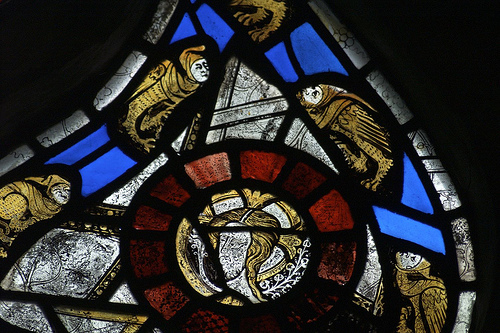
Brocklesby, Lincolnshire, originally uploaded by Vitrearum.
Yesterday, with the Revd Gordon Plumb as my guide, I went to the glorious estate church at Brocklesby in Lincolnshire. Brocklesby is a fascinating place. The estate is the property of the Earl of Yarborough and among its treasures is the stable clock designed John Harrison the inventor of the marine chronometer, which still keeps good time. The church is a treasure house of monuments to the Earl's family, the Pelhams, but it also has rather a lot of fourteenth glass, including the two glorious panels I want to draw to your attention. The glass dates to around c.1340 and is in the tracery of the window. In the first panel (see above) we see the head of Christ set within a roundel, and in the border a whole series of funny little figures, grotesque hybrids, with the cowled head of a man the legs of a ...well, what is it, a bird or a beast?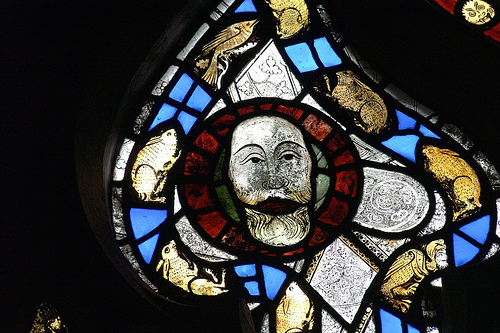
Then we have the second panel. In the centre is this funny looker and in the borders a whole array of different things, for or five hare, a fledgling bird on a branch and another one of the hybrid thingies. All glorious stuff.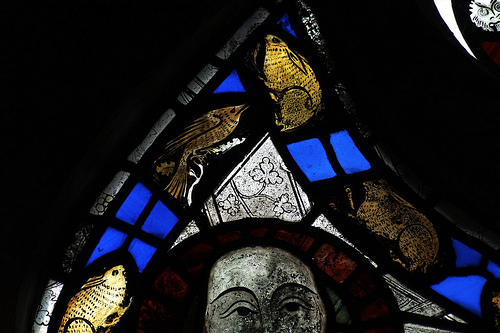
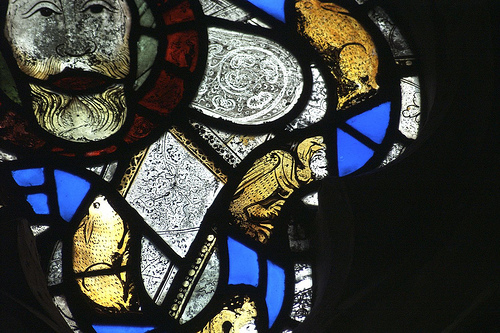
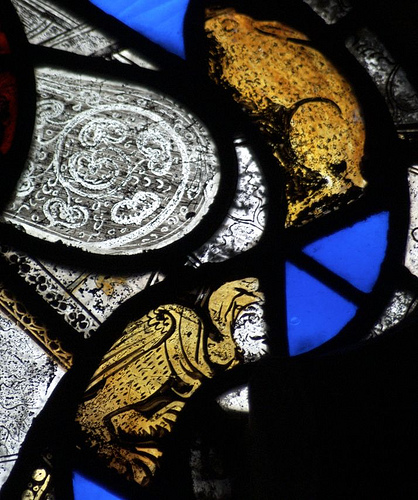
These odd sort if images in borders, marginalia or 'images on the edge' as Michael Camille called them, were fairly common in the first half of the fourteenth century. The architecture and art of the 'Decorated' style is full of imagery, all part of the supporting decoration, that sometimes lightly and sometimes more strongly poke fun at life. People in this period obviously had a strong sense of fun and these images let a little bit of lightness into the seriousness of a church building and the worship that went on in it. Sadly as we move into the late fourteenth century this sort of imagery gradually disappeared and by the fifteenth century, in glass particularly, the images on the edge had become a lot more conventional.
I saw some more marginalia at Messingham a few miles down the road, so expect a second installment in a day or two.
Further reading
P. Hebgin-Barnes, The Medieval Stained Glass of Lincolnshire (CVMA, Summary Catalogue 3, 1996), pp. 57-61)
M. Camille, Image on the Edge. The Margins of Medieval Art (London, 1992)
- An Unusual Kneeling Donor
Cumnor, Berkshire, originally uploaded by Vitrearum.This early sixteenth century roundel at Cumnor in Berkshire, isn't a particularly distinguised piece of glass painting. It is however rather interesting. It appears to show a female kneeling donor...
- Wodshawe And Twygge
As well as the glorious vestment fragments posted previously, Buckland in Gloucestershire has a number of panels of medieval stained glass. The east window has three panels from a Seven Sacrament window of the late fifteenth century, including this panel...
- Baby Jesus Having A Quick Dip
South Ormsby, Lincolnshire, originally uploaded by Vitrearum.I can't resist posting a photo of this glorious little panel of Netherlandish stained glass from South Ormsby in Lincolnshire. This tiny panel dates from the last quarter of the fifteenth...
- Workshop Technique - Glass From East Harling, Norfolk
East Harling, Norfolk, originally uploaded by Vitrearum.The east window of the East Harling church contains a considerable amount of late fifteenth century stained glass of the Norwich school. The window is composite, and among the panels are a series...
- Pre-reformation Devotional Images Of Our Lady
This glorious fragment of sculpture was discovered in 1879 walled up within Anwick church in Lincolnshire. It is a remarkable survival. It is a seated figure of the Virgin and Child, dating from the early years of the fourteenth century. Sadly it has...
